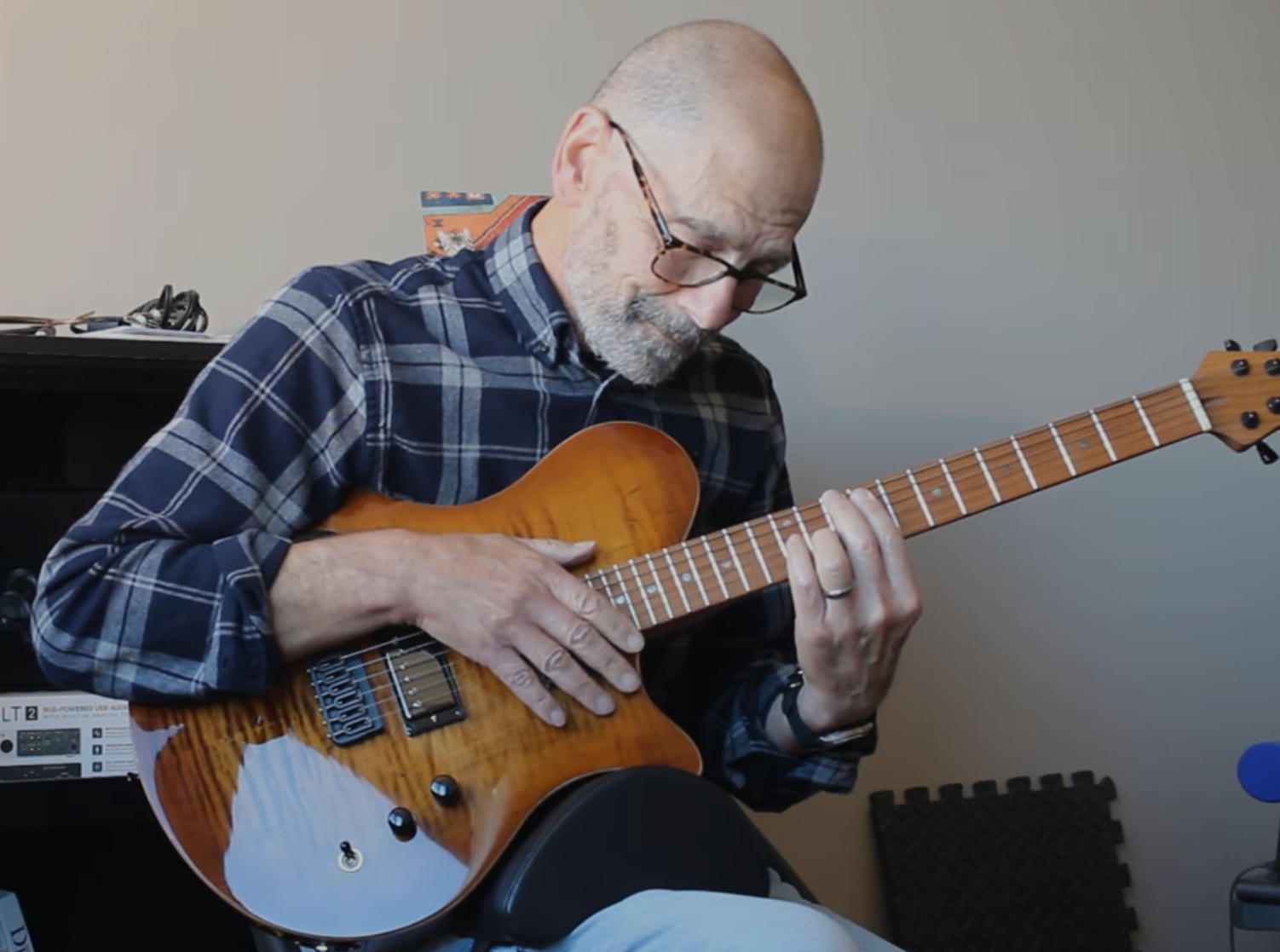The excerpts below are from a conversation with Jim Soloway about his original motivation and vision for Soloway Guitars.
Soloway Guitars remains committed to the vision Jim struck.
Sustain the note, if you will.
- Chris Cole
sustain

sustain

- The Problems Players Face
I think it was 1992. I was playing archtops then, and I had this gig in a very nice, fancy 1930s hotel in Los Angeles. There was a disco rave booked upstairs, and the hotel hired me and a percussionist to play in the lobby so people coming into the building would be hearing quiet, soft jazz that made the place feel like it had some style.
We were set up in this soaring, arched, domed lobby, almost an atrium, and it was all marble and stone. So of course everything is echoing and I could not stop the guitar from feeding back. I'm standing 20 feet behind my amplifier and I just couldn't kill the feedback.
That's what playing an archtop was all about for me. You're in constant war with controlling the guitar. They were big, they were clumsy, they were fragile, they had feedback problems.

- The Switch
And being a Canadian, arch tops were not as big here because they weren't made here. We didn't have the tradition. The two most prominent jazz guitar players in Canadian history - Lenny Breau and Ed Bickert - were well-known for playing jazz on solid bodies.
Ed Bickert was the man who explored the Jazz Telecaster. And that's how I got into playing with a Telecaster.

- The New Problem
But now that I had experienced the comfort of a smaller guitar, I had a problem. I wanted an archtop sound without the hassles of an archtop. I wanted the comfort of a small body guitar but with the warmer, more acoustic sound of an archtop.
All I wanted was a guitar that would work better for me so that I could happily play all these gigs I had. I was driven to try to solve musical problems. I went through 33 guitars and never found the solution that worked for me.
I finally decided to start making them myself.

- The Player Experience
Being a guitar player was always more important to me than building guitars. So my thinking was How do I make my experience of playing guitar better for me?
At the time I was playing 3-hour gigs with no break. I don't want to hear about 10 lb guitars. Why would I want a 10 lb guitar hanging off my shoulder and by the end of the night I’m in pain?
Or an archtop that is projecting 4 inches from my body that I have to reach around?

- Challenges
So I thought about what I wanted.
First, a guitar that is far more comfortable so I can play 3 hour gigs without pain.
Second - Tone is really just about the tonal concept you have in your head and I had two competing tonal concepts in mind. First, cop arch top tones without any of the hassles of an archtop. But I also wanted sustain closer to a solid body.
So the overall Challenge was How do I make a comfortable, lightweight guitar that sounds like an archtop but has sustain?

- The Single 15
The Single 15 was my attempt to really get both the comfort and the tone. With the 15” S15, I had some real air moving in the guitar, so the guitar had an acoustic presence.
But it was stable. It had better intonation. There was no feedback. And it was much more comfortable than any archtop I played. Far more comfortable.
This was giving me all the comfort of a standard, solid body. The arm contour provided a more natural playing position with your arm laying across a curved surface with nothing cutting into your arm. It put your hand right in playing position.
And when you play one for the first time, it’s like wow, there's something going on here that's really different.

- Innovation
So many people just want to recreate the past. I don't. That didn't mean anything to me. We were always about looking forward – how can we make a better guitar for players?
That's what Soloway Guitars is at its best.

- Looking Forward
Chris, when you look at what you've done, what you have now with the S14… Do you know what you've built?
You've taken up where I left off. You said OK, how do we make it even more comfortable? How do we make this sound even better? How do we make this a better tool for the player. You turned to a more sustainable wood supply. You switched to roasted torrefied woods for the neck. You have a better build process. And you designed that beautiful carve behind the heel. The S14 is really comfortable at 14 inches. You still have lots of air in that body but it's even lighter.
It's a great tool guitar. And that's what it should be. Guitars should always be a tool first and foremost. That's the philosophy. We should be making instruments that work better.

Please rotate mobile device to landscape (horizontal) to view this content.
- The Problems Players Face
I think it was 1992. I was playing archtops then, and I had a gig in a fancy 1930s hotel in Los Angeles. The hotel hired me to play in the lobby so people would hear soft jazz that made the place feel upscale. We were set up in this soaring, domed lobby, an atrium - all marble and stone. Of course everything is echoing and I could not stop the guitar from feeding back. I'm 20 feet behind my amp and couldn't kill the feedback.
That's what playing an archtop was all about for me - constant war with controlling the guitar. They were big, they were clumsy, they were fragile, they had feedback problems.

- The Switch
And being a Canadian, arch tops were not as big here because they weren't made here. We didn't have the tradition. The two most prominent jazz guitar players in Canadian history - Lenny Breau and Ed Bickert - were well-known for playing jazz on solid bodies.
Ed Bickert was the man who explored the Jazz Telecaster. And that's how I got into playing with a Telecaster.

- The New Problem
But now that I had experienced the comfort of a smaller guitar, I had a problem. I wanted an archtop sound without the hassles of an archtop. I wanted the comfort of a small body guitar but with the warmer, more acoustic sound of an archtop. All I wanted was a guitar that would work better for me so that I could happily play all these gigs I had. I was driven to try to solve musical problems. I went through 33 guitars and never found the solution that worked for me.
I finally decided to start making them myself.

- The Player Experience
Being a guitar player was always more important to me than building guitars. So my thinking was How do I make my experience of playing guitar better for me?
At the time I was playing 3-hour gigs with no break. I don't want to hear about 10 lb guitars. Why would I want a 10 lb guitar hanging off my shoulder and by the end of the night I’m in pain? Or an archtop that is projecting 4 inches from my body that I have to reach around?

- Challenges
So I thought about what I wanted.
First, a guitar that is far more comfortable so I can play 3 hour gigs without pain. Second - Tone - I had two competing tonal concepts in mind. Cop arch top tones without the hassles of an archtop. Sustain closer to a solid body.
So the overall Challenge was How do I make a comfortable, lightweight guitar that sounds like an archtop but has sustain?

- The Single 15
The Single 15 was my attempt to really get both the comfort and the tone. The 15” S15 had some air moving in the guitar, so it had an acoustic presence.
But it was stable. It had better intonation. There was no feedback. And it was far more comfortable than any archtop I played. The arm contour provided a more natural playing position with your arm laying across a curved surface with nothing cutting into your arm. It put your hand right in playing position.
And when you play one for the first time, it’s like wow, there's something going on here that's really different.

- Innovation
So many people just want to recreate the past. I don't. That didn't mean anything to me. We were always about looking forward – how can we make a better guitar for players?
That's what Soloway Guitars is at its best.

- Looking Forward
Chris, when you look at what you have with the S14… Do you know what you've built? You've taken up where I left off. You said How do we make it even more comfortable? Sound even better?
You switched to roasted torrefied woods for the neck. You have a better build process. You designed that beautiful carve behind the heel. You improved the neck stability. You still have lots of air in the body but it's even lighter.
It's a great tool guitar, and that's what it should be. Guitars should always be a tool first and foremost. We should be making instruments that work better.


